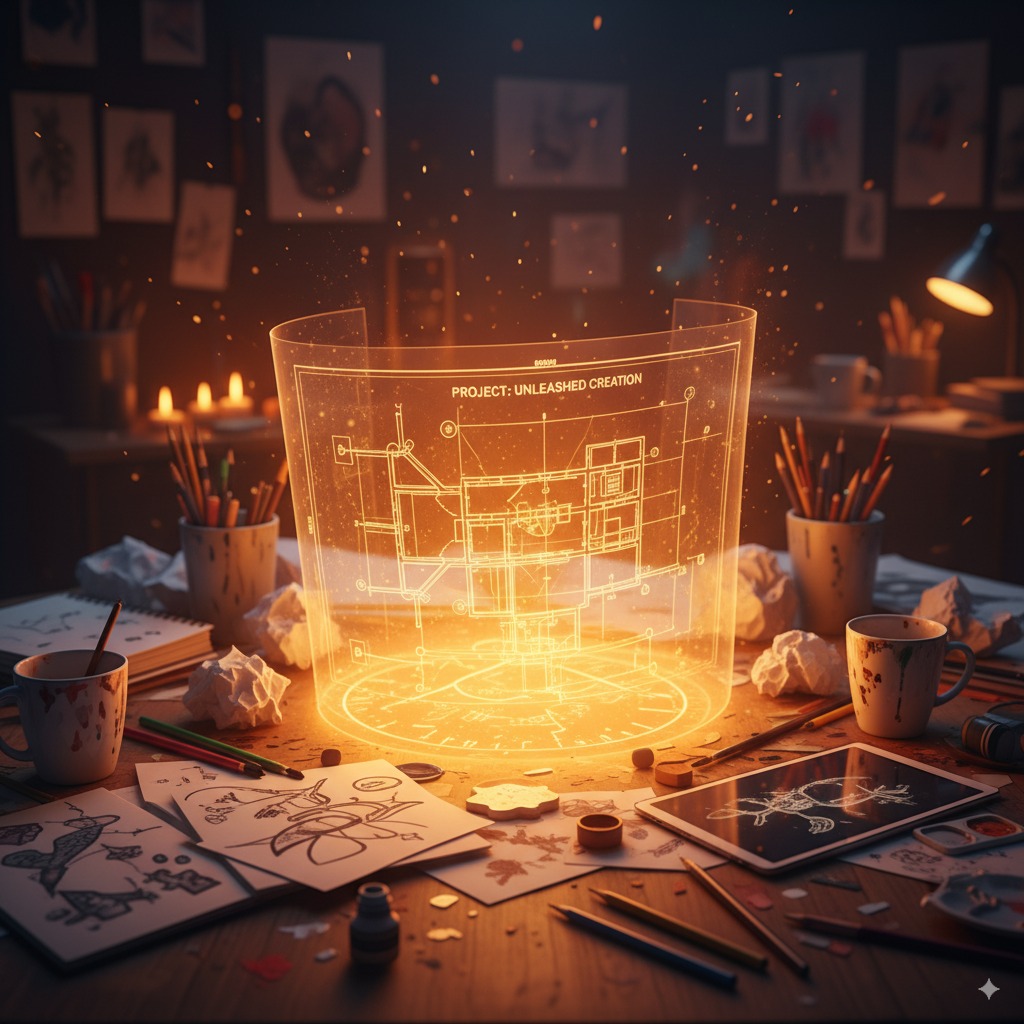My Bread and Butter
Most people run from chaos. I run toward it.
For me, chaos isn’t an accident or a failure. It’s bread and butter. It’s oxygen. It’s the fuel that keeps my ADHD brain firing. Give me a cluttered brief, a broken system, a mess of half-baked slides, and I’ll come alive. My dopamine spikes, my neurons race, and suddenly I see patterns where others see noise.
Chaos doesn’t scare me. Boredom does.
The Problem: Our Fear of Chaos
The world is addicted to order. Schools reward neat handwriting, not messy creativity. Corporations reward compliance, not improvisation. Cultures idolize predictability: diplomas, job titles, five-year plans.
But order, left unchecked, breeds mediocrity. It creates safe but soulless outputs.
Some stats:
- A University of Minnesota study found that participants in disorderly environments generated more creative ideas than those in orderly ones.
- A Princeton Neuroscience Institute study showed that visual clutter increases cognitive stimulation, the exact opposite of what minimalist culture tells us.
- In business, McKinsey reports that “agile,” adaptive organizations outperform rigid ones by 70% on innovation metrics.
Chaos isn’t the problem. Our fear of it is.
Personal Anecdote: The Mess That Made the Deck
One of my most successful client decks started as a disaster. The client dumped a hundred slides on me, walls of text, contradictory numbers, graphics from three different decades. It was chaos incarnate.
Most people would’ve panicked. I smiled.
I spread the slides across the floor. I walked around them like an evidence board. My ADHD brain lit up. Within hours, I wasn’t seeing chaos anymore. I was seeing the story inside the mess.
By the end of the week, I had distilled 100 slides into 25. Clean, sharp, undeniable. The client didn’t just thank me, they asked how I “saw” the story when they couldn’t.
The answer: Chaos is my raw material.
Framework: Chaos as Creative Energy
Here’s how I think about it:
Order = Execution. Order helps you finalize, polish, and deliver.
Chaos = Discovery. Chaos is where breakthroughs live.
The process:
- Immerse in Chaos. Don’t fight the mess, dive into it, stay there, embrace it, and breathe.
- After a while, you will start spotting the Patterns. Look for repetition, contradiction, tension.
- Extract the Signal. Pull the story from the noise.
- Impose Order at the End. Only after discovery do you bring structure.
This mirrors the creative chaos theory: divergent thinking (chaos) followed by convergent thinking (order). Without the first, the second produces bland work.
ADHD and Dopamine in Chaos
Why do I thrive in chaos? ADHD.
ADHD brains are dopamine-hungry. Routine and predictability starve us. Novelty and challenge feed us.
- Research in Psychiatry Research shows ADHD brains have lower baseline dopamine, which is why we chase stimulation.
- A study in Personality and Individual Differences found ADHD adults scored higher on divergent thinking tasks, often fueled by chaotic stimuli.
- Rejection sensitivity and hyperfocus combine to make us zero in on the “signal” hidden inside the noise.
Where others drown in chaos, ADHD minds often surf it.
Cultural Layer, The French Discipline vs. Creative Mess
Growing up in France, I was taught that order equaled discipline. Neat notes. Diplomas in frames. Perfectly ironed shirts. Mess was a sign of weakness.
But ironically, my biggest creative leaps came when I broke that conditioning. When I embraced the pile of sketches, the scattered research notes, the prototype that looked ugly before it looked good.
France gave me the discipline to value order. ADHD gave me the drive to embrace chaos. The creative sweet spot lives in between.
Data: The Cost of Over-Order
Order feels safe, but it kills innovation when overdone.
- A Harvard Business School study found that companies with excessive process controls experienced 20–30% slower innovation cycles.
- Deloitte reports that rigid hierarchies reduce employee idea generation by 50% compared to flexible environments.
- Neuroscience shows that novelty (often chaotic) activates the hippocampus, enhancing memory and learning.
In short: too much order isn’t efficient. It’s expensive.
Actionable Takeaways
If you want to turn chaos into raw material instead of fearing it:
Reframe Chaos as Data.
Stop calling it a mess. Start calling it raw inputs.
Use Physical Space.
Lay out ideas physically (on walls, floors, whiteboards). ADHD brains thrive on spatial chaos.
Time-Box It.
Give yourself 90 minutes to play in chaos before imposing order. Or just put it on the back burner. Sleep on it. Picture your grandma’s stew, cooking forever…
Extract Three Patterns.
After immersion, write down the three strongest patterns you see. Build from there.
Keep Chaos Rituals.
For me, it’s dumping all drafts on the floor. For you, it might be a wall of sticky notes.
Conclusion: Bread, Butter, and Chaos
Chaos isn’t an enemy to be defeated. It’s a resource to be mined.
Yes, order has its place, it polishes, delivers, reassures. But chaos is where the spark comes from. It’s the bread and butter of creativity.
So the next time you feel overwhelmed by a mess of inputs, remember: there’s a story hiding inside. And if you lean into the chaos instead of running from it, you just might find the thing that makes your work undeniable.
Because chaos doesn’t destroy creativity. It is creativity, in its rawest form.
Still Hungry?
Don’t stop here. If this post lit a spark, you’ll want to dive into more ideas cut from the same cloth, sharper thinking, bolder design, and zero fluff.
The Day I Fired My “Inner Impostor Boss”
How ADHD magnifies impostor syndrome and what it takes to shut it down.
From Corporate Costume to Thin Creative Skin
Why hiding behind conformity kills originality and how authenticity is your new armor.
Permission Slips for Reinvention - Why no one else is going to hand you one.
Stop waiting for diplomas, managers, or permission... write your own slip.


